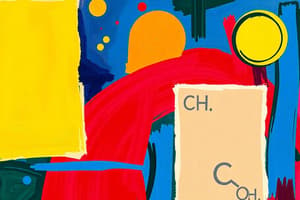Podcast
Questions and Answers
What is the smallest unit of a compound called?
What is the smallest unit of a compound called?
- Mixture
- Element
- Atom
- Molecule (correct)
What does the subscript in a chemical formula indicate?
What does the subscript in a chemical formula indicate?
- The number of molecules
- The number of elements
- The percentage composition
- The number of atoms of each element (correct)
What does the empirical formula represent for a compound?
What does the empirical formula represent for a compound?
- The physical state of the compound
- The percentage composition
- The simplest whole number ratio of atoms (correct)
- The number of electrons
Which of the following best describes a chemical formula?
Which of the following best describes a chemical formula?
What is the molecular formula of a compound?
What is the molecular formula of a compound?
What does the percentage composition of a compound tell us?
What does the percentage composition of a compound tell us?
Which of the following is formed when two or more elements chemically combine in a fixed ratio by mass?
Which of the following is formed when two or more elements chemically combine in a fixed ratio by mass?
What is a mixture?
What is a mixture?
What is the chemical formula for water?
What is the chemical formula for water?
What does the law of definite proportions state?
What does the law of definite proportions state?
Flashcards are hidden until you start studying
Study Notes
The Language of Chemistry
- A symbol is the abbreviation of the Latin or short form, and the first letter of the symbol of an element is always capital.
- Elements have Latin names, which can be used to derive their symbols.
Symbols and Latin Names
- Hydrogen -> H
- Carbon -> C
- Nitrogen -> N
- Oxygen -> O
- Gold -> Au (from Aurum)
- Silver -> Ag (from Argentum)
- Potassium -> K (from Kalium)
- Copper -> Cu (from Cuprum)
- Mercury -> Hg (from Hydrargum)
- Tin -> Sn (from Stannum)
- Iron -> Fe (from Ferrum)
- Lead -> Pb (from Plumbum)
- Sodium -> Na (from Natrium)
- Tungsten -> W (from Wolfram)
Polynomials
- A polynomial is an expression consisting of variables and coefficients, involving only addition, subtraction, multiplication, and non-negative integer exponents of variables.
- Polynomials can have more than one variable.
- The exponents of the variable in a polynomial must always be non-negative integers.
- Polynomials can be extended to more than one variable.
Combining Like Terms
- When adding or subtracting polynomials, if a particular term appears more than once, we can combine the terms by adding up their coefficients.
- This is known as combining like terms.
Drawing the Structure of Monomers
- The formula of a long chain polymer is defined in brackets with the subscript n indicating the number of repeating units in the chain.
- A curly bracket with a subscript n is used to show that there are n units of the monomer.
- The structures should be shown between brackets and linked by a bond.
The Calculation of the Mean, Median, and Mode
- The mean can be calculated using the formula: x̄ = (f₁x₁ + f₂x₂ + ... + fnxn) / (f₁ + f₂ + ... + fn)
- The median is the middle value of the data set, which can be found by arranging the data in ascending order and finding the middle value.
- The mode is the class with the highest frequency.
Chemical Calculations
- The formula for percent composition is: Percent composition = (Mass of the element in the molecule / Mass of the molecule) x 100
Empirical Formula
- The empirical formula is the simplest whole number ratio of atoms in a molecule.
- It can be determined by converting the given mass of each element to moles, dividing each mole value by the smallest mole value, and multiplying by a common factor to convert them into whole numbers.
Determining Molecular Formula
- The molecular formula gives the actual number of atoms of each element present in the molecule.
- It can be determined by calculating the empirical formula mass of the compound, dividing the molecular mass by the empirical formula mass, and multiplying the subscripts in the empirical formula by the number obtained.
Points to Remember
- A compound is a substance formed when two or more elements chemically combine in a fixed ratio by mass.
- The smallest unit of a compound is called a molecule, which can be made up of one or more atoms.
- The formulae of compounds represent the number and kinds of atoms present in one molecule of the compound.
- Chemical formulae are the symbolic representation of a compound.
- The subscript in the formula indicates the number of atoms of each element present in one molecule of the compound.
- The percentage composition tells us the percentage of each element present in the compound.
- The empirical formula represents the simplest whole number ratio of atoms present in the compound.
- The molecular formula represents the actual number of atoms present in a single molecule of the compound.
Studying That Suits You
Use AI to generate personalized quizzes and flashcards to suit your learning preferences.





